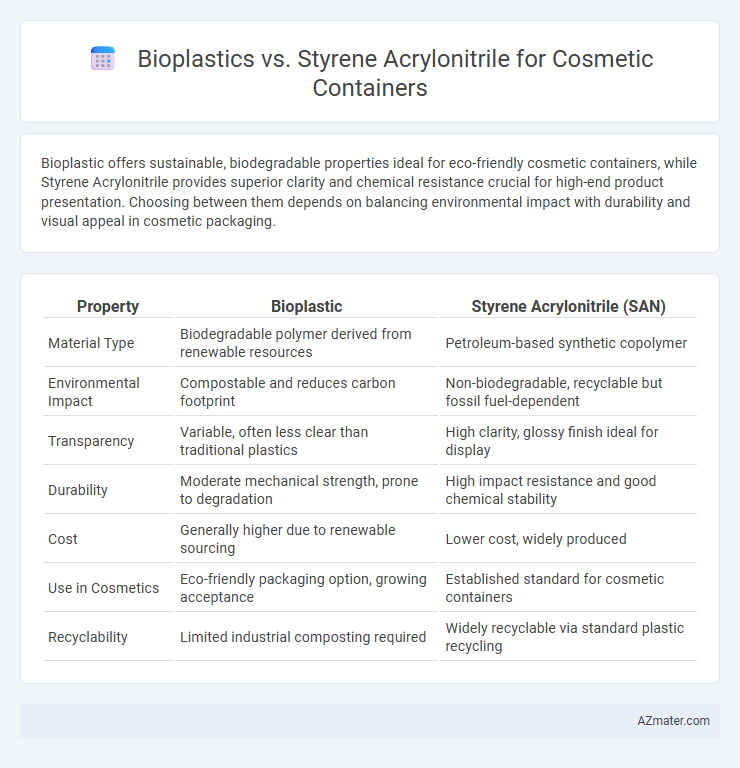Bioplastic offers sustainable, biodegradable properties ideal for eco-friendly cosmetic containers, while Styrene Acrylonitrile provides superior clarity and chemical resistance crucial for high-end product presentation. Choosing between them depends on balancing environmental impact with durability and visual appeal in cosmetic packaging.
Table of Comparison
| Property | Bioplastic | Styrene Acrylonitrile (SAN) |
|---|---|---|
| Material Type | Biodegradable polymer derived from renewable resources | Petroleum-based synthetic copolymer |
| Environmental Impact | Compostable and reduces carbon footprint | Non-biodegradable, recyclable but fossil fuel-dependent |
| Transparency | Variable, often less clear than traditional plastics | High clarity, glossy finish ideal for display |
| Durability | Moderate mechanical strength, prone to degradation | High impact resistance and good chemical stability |
| Cost | Generally higher due to renewable sourcing | Lower cost, widely produced |
| Use in Cosmetics | Eco-friendly packaging option, growing acceptance | Established standard for cosmetic containers |
| Recyclability | Limited industrial composting required | Widely recyclable via standard plastic recycling |
Introduction to Cosmetic Packaging Materials
Bioplastic and Styrene Acrylonitrile (SAN) are prominent materials in cosmetic packaging, each offering unique benefits for product safety and aesthetics. Bioplastics provide a sustainable alternative derived from renewable resources, enhancing eco-friendliness and biodegradability in cosmetic containers. Styrene Acrylonitrile is preferred for its excellent clarity, chemical resistance, and durability, making it ideal for high-quality, transparent cosmetic packaging.
Overview of Bioplastics in Cosmetic Containers
Bioplastics in cosmetic containers offer a sustainable alternative to conventional plastics by being derived from renewable biomass sources such as cornstarch, sugarcane, and cellulose, reducing environmental impact and carbon footprint. These materials provide comparable durability and chemical resistance to Styrene Acrylonitrile (SAN) while enhancing biodegradability and compostability, crucial for eco-conscious consumers and packaging regulations. Emerging innovations in bioplastics include polylactic acid (PLA) and polyhydroxyalkanoates (PHA), which maintain product integrity and aesthetic appeal while promoting circular economy practices within the cosmetics industry.
Styrene Acrylonitrile (SAN): Properties and Uses
Styrene Acrylonitrile (SAN) exhibits excellent chemical resistance, high clarity, and superior toughness, making it ideal for cosmetic containers requiring durability and aesthetic appeal. Its resistance to heat and impact enables safe storage of various cosmetic formulations without degrading or leaching harmful substances. SAN's ability to be easily molded and colored enhances customization options for cosmetic brands seeking both functionality and visual appeal in their packaging solutions.
Environmental Impact: Bioplastic vs SAN
Bioplastic cosmetic containers generally offer a lower environmental impact than Styrene Acrylonitrile (SAN) due to their renewable, biodegradable properties derived from biomass sources like corn or sugarcane. SAN, a petroleum-based plastic, exhibits higher carbon emissions and persistence in landfill environments, contributing to long-term pollution and microplastic contamination. Life cycle assessments reveal bioplastics reduce fossil fuel dependency and greenhouse gas emissions, making them a more sustainable option for eco-conscious cosmetic packaging.
Biodegradability and End-of-Life Scenarios
Bioplastic cosmetic containers offer superior biodegradability compared to Styrene Acrylonitrile (SAN), as bioplastics typically break down naturally within months under composting conditions, minimizing environmental impact. SAN, a petroleum-based polymer, resists degradation and often ends up in landfills or incineration, contributing to long-term plastic pollution. Bioplastics support circular economy initiatives through composting or industrial biodegradation, whereas SAN containers rely heavily on recycling processes that are less efficient and less widely available.
Mechanical and Aesthetic Properties Comparison
Bioplastic offers superior environmental benefits with moderate mechanical strength, exhibiting good flexibility and impact resistance but lower hardness compared to Styrene Acrylonitrile (SAN). SAN provides excellent rigidity, chemical resistance, and a high-gloss finish, enhancing the aesthetic appeal of cosmetic containers with clear transparency and smooth surface texture. While SAN excels in durability and visual clarity, bioplastic containers are gaining traction for sustainable packaging without significantly compromising functionality or appearance.
Regulatory and Safety Considerations
Bioplastic cosmetic containers comply with stringent regulations such as FDA Title 21 CFR and EU REACH, offering enhanced biodegradability and reduced toxicological risks compared to Styrene Acrylonitrile (SAN), which is scrutinized for potential styrene migration and associated health concerns. SAN containers require rigorous testing to meet FDA and EU safety standards, particularly regarding chemical stability and leachables, making them less favorable in markets with strict environmental and safety regulations. Regulatory trends increasingly favor bioplastics due to their sustainable lifecycle and lower environmental impact, promoting safer cosmetic packaging aligned with global health policies.
Cost Analysis and Market Availability
Bioplastic cosmetic containers often entail higher production costs compared to Styrene Acrylonitrile (SAN), with prices influenced by raw material sourcing and sustainable manufacturing processes. SAN offers a cost-effective solution with widespread market availability, benefiting from established supply chains and bulk production economies. Despite the premium pricing, bioplastics are gaining traction driven by increasing consumer demand for eco-friendly packaging in the cosmetics sector.
Consumer Perceptions and Brand Implications
Consumer perceptions of bioplastic cosmetic containers emphasize eco-friendliness and sustainability, appealing to environmentally conscious buyers seeking reduced plastic waste. Styrene acrylonitrile (SAN) offers durability and clarity, associated with premium product quality but may raise concerns about environmental impact and chemical safety. Brands leveraging bioplastic packaging can enhance their green image and attract a growing market segment prioritizing ethical consumption, while SAN containers remain favored for luxury appeal and product visibility.
Future Trends in Cosmetic Packaging Materials
Bioplastic offers a sustainable alternative to Styrene Acrylonitrile (SAN) for cosmetic containers, driven by increasing consumer demand for eco-friendly packaging. Innovations in biodegradable polymers and bio-based composites enhance the performance and aesthetic appeal of bioplastic, positioning it as a key material in future cosmetic packaging. The trend towards circular economy principles and regulatory pressures on plastic waste are accelerating the adoption of bioplastics over traditional SAN containers.

Infographic: Bioplastic vs Styrene Acrylonitrile for Cosmetic Container
 azmater.com
azmater.com